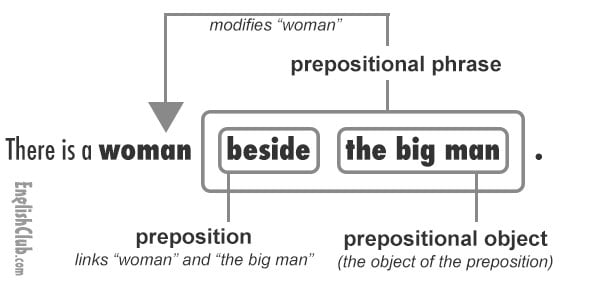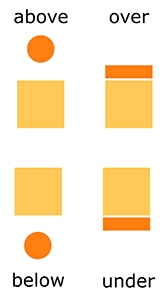Easy Way to Teach Prepositional Phrases Fifth Grade
The author of the ebook "English Prepositions List" summarizes some of the key points to understand when teaching prepositions and offers tips to make your teaching more effective
 Prepositions form a small but important word class, being very frequently used. In fact, the prepositions to, of, in, for, on, with, at, by, from are all in the top 25 words in English. Helping students understand and correctly use prepositions contributes greatly to their fluency. In this article, Josef Essberger, author of English Prepositions List, summarizes some of the key points to understand when teaching prepositions and offers tips to make your teaching more effective.
Prepositions form a small but important word class, being very frequently used. In fact, the prepositions to, of, in, for, on, with, at, by, from are all in the top 25 words in English. Helping students understand and correctly use prepositions contributes greatly to their fluency. In this article, Josef Essberger, author of English Prepositions List, summarizes some of the key points to understand when teaching prepositions and offers tips to make your teaching more effective.
What do prepositions do?
A clear understanding as to what prepositions are actually for is essential for the teacher, although it may not be necessary to go in detail into the grammar points below at all levels.
Function of a preposition
The function or "job" of a preposition is to express the relationship between two words in a sentence, specifically between a noun, verb or adjective and a noun or pronoun* :
- the womanbesideJohn
- ran into the shop
- happy with you
A preposition is typically (not always) followed by a noun or pronoun (the "prepositional object") and together they form a "prepositional phrase" (beside John, into the shop, with you).
*Strictly speaking this can be a noun (including proper noun), pronoun, noun group or gerund (verb in noun form):
- noun(dog, table, love) – They arein love.
- proper noun(Bangkok, Mary) – I went to Bangkok.
- pronoun(you, him, us) – She spoke to him.
- noun group(my first job) – I was poor before my first job.
- gerund(swimming) – She is passionate about swimming.
Function of a prepositional phrase
A prepositional phrase functions as an adjective or adverb to modify a noun, verb or adjective :
- the womanbeside John ("beside John" functions as an adjective modifying the noun "woman")
- He worksbefore lunch. ("before lunch" functions as an adverb modifying the verb "works")
- happywith it ("with it"functions as an adverb modifying the adjective "happy")

Forms of prepositions
Prepositions have no particular form. The majority of prepositions are one-word prepositions, but some are two- or three-word phrases known as complex-prepositions:
- one-word prepositions (before, into, on)
- complex prepositions (according to, but for, in spite of, on account of)
"Complex prepositions" (on account of) should not be confused with "prepositional phrases" (on the table, on account of his age).
Types of prepositions
Many prepositions have more than one meaning. The meaning can be literal (in the box) or metaphorical (in love). The literal meanings fall into several categories, for example:
- place — under the bed
- time — on Sunday
- movement — towards the horizon
- manner — by train
- means — with a blunt instrument
- accompaniment — without a job
- possession —a friend of mine
- purpose —done for charity
Note that many prepositions belong to more than one category (eg on the table/on Monday, with her friend/with a screwdriver).
A pronoun following a preposition should be in object form
The noun or pronoun that follows a preposition forms a 'prepositional object'. If it is a pronoun, it should therefore be in the objective form (me, her, them), not subjective form (I, she, they):
- This is from my wife and me.
- That's between him and her.
- Mary gave it to them.
Teach by "meaning" category
While you could in theory teach prepositions in alphabetical order, it is generally more helpful to teach them in categories based on meaning, for example:
- prepositions of place — in the box, behind you, over my head
- prepositions of time — on Monday, in 1948, during the day, at night
- prepositions of movement — past the door, through the fence, across the road
By limiting a lesson to prepositions of space, for example, learners can compare, contrast and comprehend the meanings directly (on/under, inside/outside). This works better than trying to teach the various meanings of individual prepositions (on the table, on Monday, on purpose, on time).
Say farewell to the "end of a sentence" myth
Some people claim that a preposition must always come before its object. Although a preposition usually precedes its object, it can sometimes come after its object. Take the very common " Where are you from ?" and "I am from England ." The object of from is clearly Where and England . While one could theoretically say " From where are you?", no-one actually does say that. Normal English usage is "Where are you from?"
There are four main cases where a preposition may naturally fall at the end of a sentence or clause:
- who, where, what questions —What are you interested in?
- relative clause —the plan (that) they are working on
- infinitive —Do you have someone to go with?
- passive —She hates being stared at.
pre-position means place before
The name "preposition" indicates that prepositions come before something:
- I put it in the box.
But even when a preposition does not come before its object, it is still closely linked to its object:
- Who(m)did you talk to?
- I talked to Jane.
Many prepositions can also be adverbs
It may help your more grammar-oriented students to recognize the difference between a preposition and an adverb. A preposition always has an object. An adverb does not have an object.
- They are in the kitchen. (preposition in has object the kitchen)
Please come in. (adverb in has no object) - There was a doorway before me. (preposition before has object me)
I had never seen it before. (adverb before has no object) - I will call after work. (preposition after has object work)
He called soon after. (adverb after has no object)
Good news. Prepositions are limited in number
Although prepositions may seem difficult to learn, the task is not insurmountable. There are only 150 prepositions and only about 70 of these are commonly used. What's more, all single-word prepositions are "closed-class", meaning they are unlikely to be added to.
to preposition vs to infinitive
The infinitive particle "to" (to sing, to live) often befuddles English learners who may confuse it for the preposition "to" (to London, to me).
to as preposition
- I look forward to lunch
I look forward to seeing you
I look forward to see you - They are committed to the project.
They are committed to keeping the price down.
They are committed to keep the price down. - I am used to cars.
I am used to driving.
I am used to drive.
to as infinitive particle
- They used to live in Moscow.
- They love to sing.
Use simple illustrations
Help students understand prepositions of place and movement with simple illustrations.

Where appropriate, try to find contrasting pairs to make the meaning clearer.

Illustrations from English Prepositions List
Use preposition activities
Try to use fun activities in teaching your students and checking their understanding. You can find many preposition games and quizzes that can be used online or offline. The ebook English Prepositions List includes printable preposition quiz sheets (with answers) ideal for classroom use.
Be aware of first-language interference
Be aware that some languages may use a preposition where English does not. So, depending on a student's first language, you may hear for example:
-
Will you marry with me?(marry me) -
He entered to the room.(entered the room) -
I hate from that.(hate that) -
They discussed about the problem.(discussed the problem) -
I have paid for the bill.(paid the bill)
Or, conversely, some languages use no preposition where English requires one:
-
She reminds me my childhood.(of my childhood) -
He is waiting the bus.(for the bus) -
She likes to listen music.(to music)
Explain the preposition rule
There is one very simple rule about prepositions. And, unlike most rules, this rule has no exceptions.**
Rule: A preposition is always followed by a "noun". It is never followed by a verb. By "noun" we include:
- noun(dog, table, love) – This is food for dogs.
- proper noun(Bangkok, Mary) – I went to Bangkok.
- pronoun(you, him, us) – She spoke to him.
- noun group(my first job) – I was poor before my first job.
- gerund(swimming) – She is passionate about swimming.
A preposition cannot be followed by a verb. If we want to follow a preposition by a verb, we must use the "-ing" form which is really a gerund or verb in noun form.
**You didn't really believe that, did you? Actually, it's more accurate to say "A preposition is always related to a noun." Normally the "noun" comes after the preposition, but occasionally it may come before it (What country do you come from?). But before or after, it is always a "noun". And "always followed by a noun" is useful at lower levels.
Try this mini preposition quiz
The rule says "a preposition is always followed by a noun". In the following sentences, why is the preposition "to" followed by a verb? That should be impossible, according to the rule above.
- I would like to go now.
- She used to smoke.
The answer is that in "I would like to go now" and "She used to smoke", the word "to" isnot a preposition. It is part of theinfinitive ("to go", "to smoke"). In 1 it is fairly obvious. In constructions like "used to do" it is less obvious.
Give contextual examples
When giving examples, and where possible, try to show prepositions in context by writing full sentences. This makes it far easier for your students to understand or deduce the meaning.
Have students use prepositions in sentences of their own
You can also test understanding by getting your students to use specific prepositions in their own original sentences. Only in this way can you know if they have fully grasped both the concept of prepositions in general and the meaning of particular prepositions.
Illustrations from English Prepositions List
See also:
How to Teach Prepositions of Position to Young Learners
macdougallnoth1952.blogspot.com
Source: https://www.englishclub.com/efl/tefl-articles/tips-for-teaching-prepositions/